You will be attracted by its appearance and loved for its taste - the Jubilee Tarasenko tomato
Legendary varieties of tomatoes, bred by a school physics teacher, gained popularity in the last century and have not lost their relevance to this day. On the contrary, they are becoming increasingly widespread due to their reliability and simple agricultural technology.
The Jubilee Tarasenko tomato is suitable for those who want to get a rich harvest from a small plot, spending a minimum amount of time and effort. The taste of ripe vegetables will please you not only in fresh salads, but also in winter preparations.
Characteristics and description of the variety
Ukrainian physics teacher and amateur gardener F. M. Tarasenko developed more than 50 types of tomato crops. The Legend Tarasenko and Yubileiny tomatoes are especially popular. The Yubileiny Tarasenko tomato variety is much older than Legend; it has been known to gardeners for 30 years. It is based on several varieties and hybrids, one of which is the Mexican variety San Marzano.
Distinctive features
The type is indeterminate, height is 2-3 m, which is why the culture is called liana-like. The stem is powerful, the foliage is weak, the leaves are large, dark green. The inflorescences are simple, growing in the form of a cluster. The clusters are complex, each producing 20-25 fruits. The first brush is formed above the 9th leaf, subsequent ones every 2 leaves.
Mid-season species, 115-120 days pass from the moment of seedlings to full ripening. Fruiting is extended, ripe vegetables are harvested within 1.5 months.
The yield is high, up to 8 kg is harvested from 1 seedling when placing 2 plants per 1 square meter. m.
Resistance to the main diseases of the nightshade family is high. The culture is immune to late blight and brown spot.
Recommended for cultivation in open ground and in greenhouse conditions. The species is resistant to low temperatures.
Tall bushes require obligatory garter and regular stepsoning.
Fruit characteristics
Average weight 90-100 g, round, slightly elongated shape, red-orange color. The taste is rich, sweet and sour. The pulp is dense, fleshy, the peel is thin but durable and does not crack.
The purpose is universal; the fruits are used fresh for preparing a variety of dishes. Thanks to their durable skin, they do not crack during salting and preservation. It is used extremely rarely in processing for tomato products; due to the dense pulp, it is almost impossible to obtain juice from tomatoes.
Tomatoes can be stored for up to several months and can withstand long-term transportation.
The photo shows Yubileiny Tarasenko tomatoes.
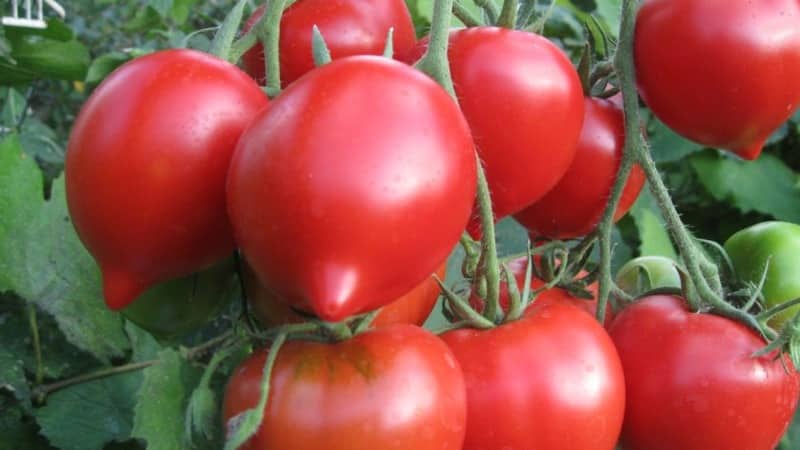
How to grow seedlings
Sowing seeds for seedlings begins 2 months before planting in the ground. Gardeners can collect seed material from their own harvest, since it is a varietal crop, which means the genetic information is preserved for years.
Seed preparation
Self-harvested grains are disinfected and prepared for sowing. Disinfection takes place in a weak solution of potassium permanganate for 20-30 minutes. Then they are washed and dried.
To improve germination, the grains are soaked in a growth stimulator for 11 hours. As a stimulant, in addition to special preparations, melt or ordinary boiled water is used.
Reference! The most commonly used growth stimulants are Epin, Kornevin and Immunocytophyte.
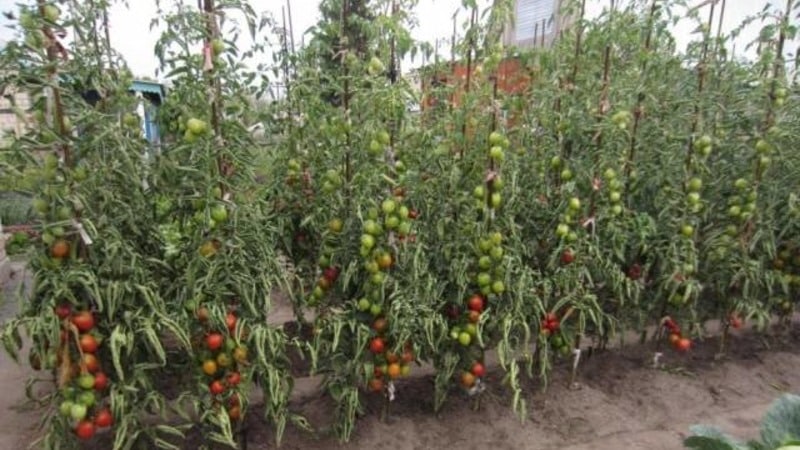
Container and soil
The soil is prepared from garden soil and humus in equal quantities. A little sawdust or washed river sand is added as a leavening agent. The resulting mixture is poured with a hot solution of dark potassium permanganate or steamed in the oven at 60 °C for 10 minutes. The cooled soil is laid out in planting containers, filling them halfway. This makes it possible to add soil to the containers as the seedlings grow, thereby providing additional nutrition.
You can plant them in a common wooden box or in individual containers, at the bottom of which drainage holes are first made. When planting in separate containers, further care for tomatoes is reduced to a minimum.
Reference! Drainage holes at the bottom of the planting containers do not allow moisture to stagnate, which prevents the development of diseases such as blackleg.
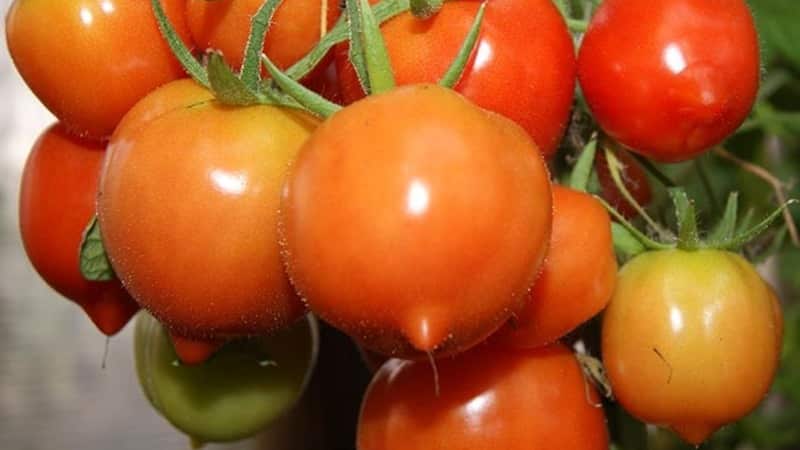
Sowing
Seeds are sown to a depth of 2 cm with a distance of 3 cm from each other. Sprinkle soil on top, lightly compact and cover the containers with film to create a greenhouse effect. Planting containers are left in a bright and warm room at a temperature of 24-25 °C. Periodically, the film is removed for ventilation and, as the upper soil layer dries out, it is moistened with warm, settled water using a spray bottle.
Seedling care
When shoots appear, the film is removed and the containers are moved to the windowsill. Since seedlings tend to stretch, it is necessary to provide a sufficient amount of light for a long time. During the first few days, experienced gardeners illuminate the plantings around the clock with electric fluorescent lamps.
Water with moderately warm, settled water along the edge of the containers using a shallow watering can. After watering, the soil is loosened with a wooden stick or an ordinary fork.
Reference! Loosening is carried out superficially so as not to touch the young roots.
When 2 true leaves appear, the seedlings are picked and placed in separate containers. During picking, strong and healthy plants are left for further development. After picking, the growth and development of seedlings is more intense.
Reference! When growing seedlings in peat containers, picking is not required.
Hardening begins 2 weeks before planting in the ground. To do this, the seedlings are taken out into the open air for 1 hour during the daytime. Gradually the time interval is increased to 12 hours. Simultaneously with daytime hardening, the night temperature in the room is reduced to 13 °C.
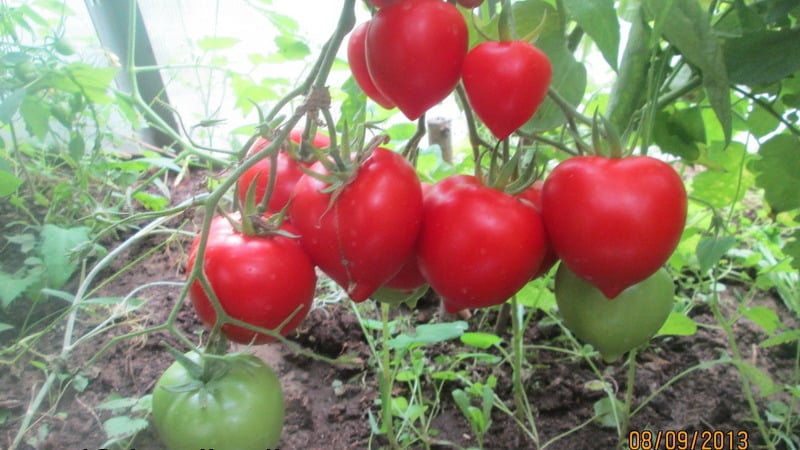
How to grow tomatoes
After 2 months, the seedlings are ready for transplanting. At this time, the bushes have 6-8 leaves and fully formed young roots.
Landing
Planting pattern: 70 cm – distance between seedlings, 90 cm left between rows. For 1 sq. m place no more than 2 plants.
The holes are prepared in advance with a depth of 30 cm, a little wood ash is placed on the bottom and filled with water. After planting, water again with warm, settled water and leave the seedlings to get used to the new place for 1 week.
Important! If the seedlings have stretched out, the bushes are placed in the holes reclining.
Planted in the evening or on a cloudy day when the sun is not shining at full strength. The holes are made in a checkerboard pattern, since this method of planting allows each seedling to receive a sufficient amount of sunlight and be well ventilated.
Further care for the Jubilee tomato
Regular watering is established as soon as the young bushes get used to the new conditions and get stronger. Water with settled water no more than 2 times a week, without flooding the seedlings. Tomato does not like excess moisture, but too little has a negative effect on the crop. The plant responds well to drip watering. To do this, place a plastic bottle without a bottom in the root system and fill it with water. Gradually moisture penetrates to the roots.
Used to retain moisture in beds mulching. Peat straw or weeds are used as mulch, which, when decomposed, provide the soil with additional beneficial substances.
After watering, the soil is loosened and hilled up to ensure a better flow of oxygen to the roots.
As plants develop, they need feeding. For the first time they are fed a week after transplantation with a complex of mineral fertilizers or organic matter. From organic matter, mullein infusion or bird droppings are used in a ratio of 1:15. Chlorine-containing fertilizers are not recommended, as is fresh manure.
The second fertilizing is applied at the time of flowering, feeding phosphorus-potassium fertilizers. The third time is fed during the fruiting period with fertilizer containing mainly potassium substances. After 3 weeks, fertilizing is repeated.
Reference! Potassium fertilizers accelerate the ripening of fruits.
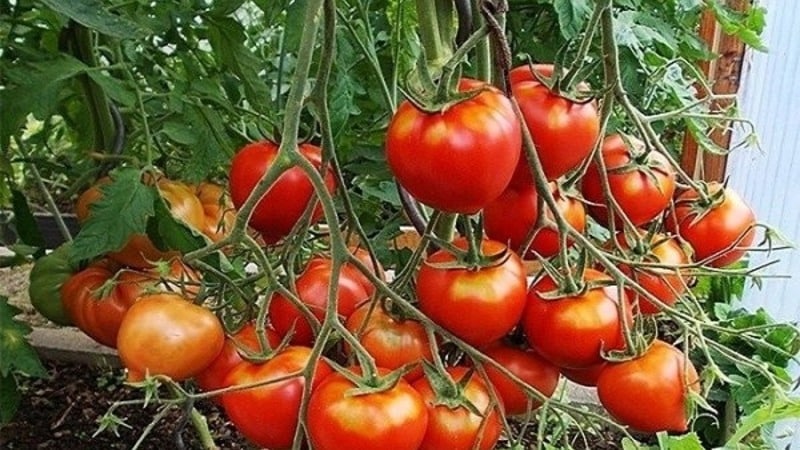
Features of cultivation and possible difficulties
Despite the powerful trunk, the plant cannot withstand the weight of the fruits, since there are too many ovaries. To avoid compromising the integrity of the bushes, they tie up to nearby supports. Not only the stem is tied up, but also the fruit-bearing branches as they develop. Another option for gartering is fixing it to a trellis.To do this, install metal supports on different sides of the bed and stretch wire between them. The bushes are fixed to the wire with soft fabric tapes.
The culture is most often formed into 1 stem. To do this, leave the strongest shoot and remove the rest. The rapid growth of bushes contributes to the frequent formation of lateral shoots. Therefore, stepchildren are removed regularly, once every 10 days. Without pinching, thickening of plantings is inevitable, which will lead to the spread of fungal infections.
Diseases and pests
The risk of fungal infection is especially high in greenhouse conditions due to constantly increased humidity and temperature. Therefore, closed structures are ventilated daily, thereby regulating the humidity level. It is also necessary to remember about prevention in the form of loosening, moderate watering and mulching of the beds. Before planting, tomato beds are watered with a solution of copper sulfate, which cleanses the soil of pathogenic spores.
When infected, plants are treated with Fitosporin or the drug HOM.
Reference! Fungal infections can destroy all plantings in 14 days.
In open ground, plants are often attacked by pests. To prevent them from multiplying quickly, seedlings are inspected every day for the presence of parasites. The inspection is carried out carefully, from all sides, since the larvae of the Colorado potato beetle are not easy to notice: they are located on the back side of the leaf. They are collected by hand. When there is a large concentration of insects, use the drug "Prestige".
To get rid of aphids, the stems are treated with a soap solution. It is done simply: 1 piece of laundry soap is dissolved in a bucket of water. If there is a large concentration of aphids, the plants are treated entirely.
Any preventive measures and spraying for treatment purposes are carried out in dry weather.
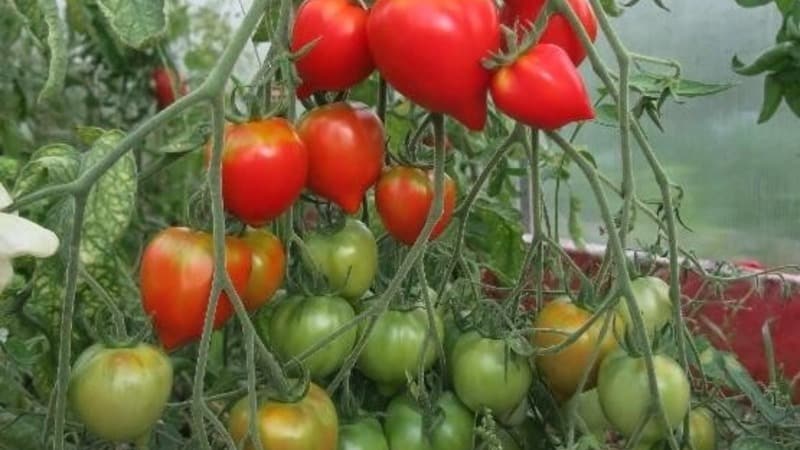
Nuances when breeding in open and protected ground
Characteristics, description of the variety and photos of bushes with numerous ovaries allow us to note the high yield. Although Tarasenko himself claims that 8 kg from 1 seedling is not the limit. If you follow the rules of crop rotation and agrotechnical practices, it is possible to double the quantitative indicator.
According to the rules of crop rotation, tomatoes are not planted twice in the same place, or change the top layer of soil, supplying it with mineral fertilizers. Good predecessors to tomato crops are: carrots, cabbage, legumes and onions. After them, the soil is not depleted and is quite capable of saturating any plant from the nightshade family.
The root system of the variety is developing, the roots do not go down, but branch underground, which allows you to feed on minerals and moisture from the soil. Therefore, Jubilee is not afraid of drought, but excess moisture is destructive.
When the plants reach 1.7-1.9 m, pinch the top, leaving 2 leaves. Otherwise, the stem will grow up to 3 m, and the developing fruits will not have enough nutrients for full development.
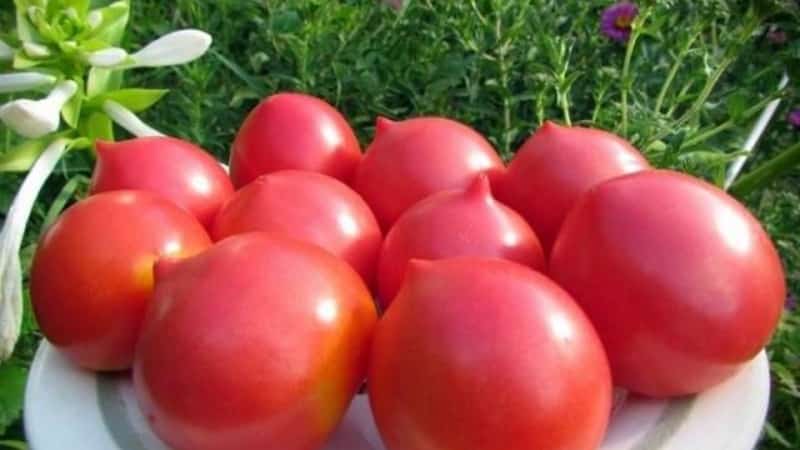
Harvesting and application
Judging by the reviews of gardeners, it is most convenient to collect Tarasenko tomatoes when they are slightly unripe. The fruits will ripen on their own in a few days, and ripening at room temperature will not affect the taste in any way. Thanks to extended fruiting, the harvest of ripe vegetables lasts up to 1.5 months.
Although the species belongs to the salad variety, the purpose of ripe vegetables is universal. They are great for fresh consumption in various dishes, marinades and pickles are made from them, and smaller tomatoes are used in whole-fruit canning. But you can’t make juice from tomatoes because of their dense pulp, but they are great for making various sauces.
The presence of a strong peel provides ripe vegetables with long-term storage and the ability to transport them over long distances without losing their presentation.
Advantages and disadvantages
The numerous advantages of the anniversary tomato are undeniable:
- adaptation to low temperatures;
- possibility of breeding in all regions;
- unpretentiousness;
- the ability to form ovaries under any conditions;
- high immunity to diseases;
- increased productivity;
- excellent taste of fruits;
- marketable condition;
- versatility in cooking;
- long storage;
- long transportation;
- the ability to independently collect seeds for planting.
Negative indicators include:
- regular stepsoning;
- need for garter;
- mandatory pinching.
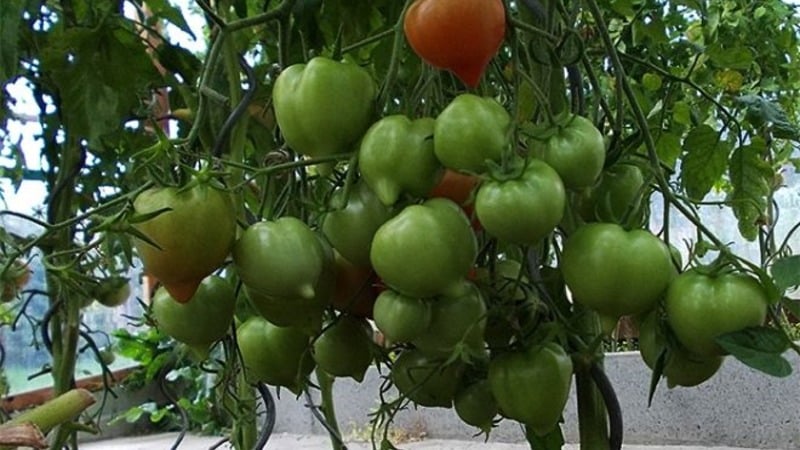
Farmer reviews
Varieties and hybrids from the physics teacher are incredibly popular among gardeners. The opinions of gardeners will convince anyone of the reliability of the crops.
Raisa, Vologda: “Last year I grew Tarasenko pink tomato, and this time I planted Yubileiny. The variety is not difficult to care for, although the bushes have reached great heights. I planted it often, watered it regularly, and as a result I got a huge amount of magnificent tomatoes with excellent taste. I’ve made a lot of preparations, now I’ll have tomatoes all winter.”
Irina, Stavropol region: “After seeing the photograph, disbelief bordered on curiosity. I couldn’t believe that a seedling could bear so many fruits.I saw it with my own eyes when I planted the variety on my plot. The bushes stood healthy all season and produced a magnificent harvest. I’m very pleased with the result.”
Conclusion
Tomato Jubilee Tarasenko, like many other works of the Ukrainian breeder, are widely known not only in Russia, but also in neighboring countries. This is not surprising, given the strengths of the culture: its high yield, cold resistance, immunity to many diseases and the excellent taste of ripe vegetables. The tomato is quite capable of taking root in the harsh conditions of Siberia under a film cover, which once again indicates the reliability and durability of the crop.